Economic Growth (Chapter 23)
曼昆经济学chapter23

• ― . . . Within a Country . . .‖
– It measures the value of production within the geographic confines of a country.
THE MEASUREMENT OF GROSS DOMESTIC PRODUCT
THE ECONOMY’S INCOME AND EXPENDITURE
• For an economy as a whole, income must equal expenditure because:
– Every transaction has a buyer and a seller. – Every dollar of spending by some buyer is a dollar of income for some seller.
Discussion
• Which contributes more to GDP——the production of an economy car or the production of a luxury car? Why? • A farmer sells wheat to a baker for $2. The baker uses the wheat to make bread, which is sold for $3. what is the total contribution of these transaction to GDP?
THE COMPONENTS OF GDP
• GDP (Y) is the sum of the following:
– Consumption (C) – Investment (I) – Government Purchases (G) – Net Exports (NX)
Alevel economic growth
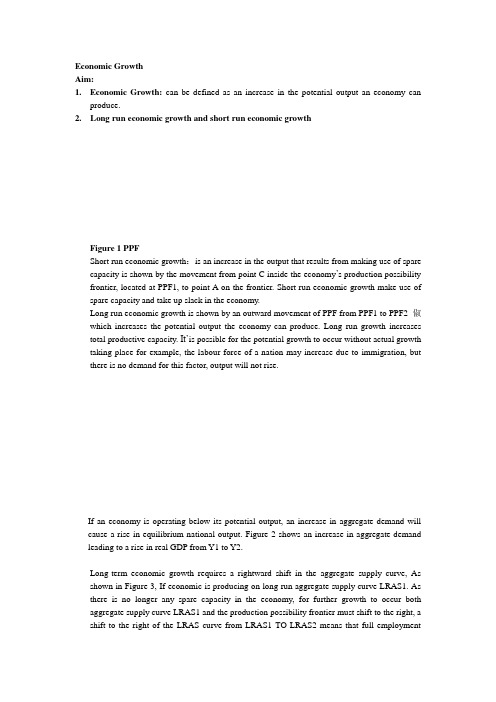
Economic GrowthAim:1.Economic Growth: can be defined as an increase in the potential output an economy canproduce.2. Long run economic growth and short run economic growthFigure 1 PPFShort run economic growth:is an increase in the output that results from making use of spare capacity is shown by the movement from point C inside the economy’s production possibility frontier, located at PPF1, to point A on the frontier. Short run economic growth make use of spare capacity and take up slack in the economy.Long run economic growth is shown by an outward movement of PPF from PPF1 to PPF2 俶which increases the potential output the economy can produce. Long run growth increases total productive capacity. It’is possible for the potential growth to occur without actual growth taking place for example, the labour force of a nation may increase due to immigration, but there is no demand for this factor, output will not rise.If an economy is operating below its potential output, an increase in aggregate demand will cause a rise in equilibrium national output. Figure 2 shows an increase in aggregate demand leading to a rise in real GDP from Y1 to Y2.Long-term economic growth requires a rightward shift in the aggregate supply curve, As shown in Figure 3, If economic is producing on long run aggregate supply curve LRAS1. As there is no longer any spare capacity in the economy, for further growth to occur both aggregate supply curve LRAS1 and the production possibility frontier must shift to the right, a shift to the right of the LRAS curve from LRAS1 TO LRAS2 means that full employmentlevel of output increased from y2 to y3.3. The cause of economic growth(1). Economic stability and macroeconomic policiesStability, particularly of growth of aggregate demand, backed by sensible government policy generates the ideal environment for business investment. Firm are more inclined to produce more goods and services and expand their operation if they expect demand to rise at a strong stable rate. Fluctuations in demand lead to business uncertainty about future prospects for revenue and profitability. Government macroeconomic policies may thus aim at promoting stability and economic growth.(2). Increase labour activity/participationEconomic growth requires an increasing percentage of the population to be actively employed, that is ,participating in labour market and successfully in finding work. Factor that has led to increase in the activity rate include-more relaxed social attitudes to women working-incentives in tax system, working tax credit-retraining schemes to overcome occupational flexibilityEvaluationSimply increase the size of population may increase GDP but it won’t increase GDP per capita.Indeed countries with rapidly growing populations can suffer falling living standards for a long time since children consume goods and services without producing them.(3).immigrationI ncreasing activity rate cannot boost economic growth indefinitely. An economic willeventually reach the point at which the activity rate can’t increase any further, All developed Economies are experiencing aging population, with an increasing percentage of the population being of retirement age, which places a burden on those of working age. Inward immigration of workers is potential source of economic growth. It can ease labour shortages.(4).increasing labour productivityLabour productivity measures output per worker per hour. It is widely accepted that labour productivity is the key to achieving high long term growth rate.(5).educational trainingMany unemployed people lack the skills required to secure a job. Government provision of training opportunities can help to tackle wider skills shortage in the economy, leading to a more flexible mobile labour force. An educated and skilled workforce will be more productive and help generate economic growth.. which also help to improve country’s international competitiveness.Disadvantage:investment in education and training is unlikely to yield immediate improvement in growth prospects(6).InvestmentInvestment is made up of replacement and new investment. Replacement is depreciation Gross investment includes replacement and new investment. So an increase in investment will lead to outward shift of AD curve. Furthermore Investment is an injection of circular flow of income. An injection into the economy will cause multiplier effect to operate and that the increase in national income is likely to be larger than the initial injection. Thirdly Investment is a crucial source of labour productivity growth Also investment will promoteR&D. It allows labour to work with more and better capital equipment, using the latest technology which will reduce the unit cost per labour per output and promote dynamic efficiency, leading to a rightward shift of AS curve. From Figure 1 blow. Initially the macroeconomic equilibrium is A with output Y1 an increase in demand and supply will lead to a higher equilibrium level of output from Y1 to Y2. Hence increase our competitiveness in international market.4. Advantage and disadvantage of economic growthIncrease in quantity and quality of factors of production(1).the obvious benefit of economic growth is a rise in the material standard of living ofhouseholds. Increasing real GDP per capita means that, on average, the population can enjoy more goods and services.(2).Economic growth produces a ‘fiscal dividend’namely the tax revenues that growthgenerates. Economic growth raises the tax revenue without having to raise tax rate, as national income increases, and some of this can be used to finance schemes to help poor.Increased tax revenue can also be used to correct market failure such as provide important public and merit goods. Such as policing and health care as well as to correct negative spillover effects upon environment(3). Economic growth provides a route out of poverty. It enables a country to reduce,eliminateabsolute poverty(4).For particular country, economic growth can generate a ‘virtuous circle’ of greater business confidence, increase investment in state of art technology, greater international competitiveness, higher profits, even more growth, and so onDisadvantage of economic growth(1).a fully employed economy, producing on its PPF, can only increase output by transferring resources from producing consumer goods and services to producing capital goods. In the short run fewer consumer goods and services will be produced. However, in the long run, the extra capital will enable more consumers good to be made. This is sometimes referred to as the choice between jam today versus jam tomorrow.(2).while economic growth has the potential to reduce poverty. it may make some of the poor worse off. The gap between the rich and poor may increase,increasing the extent of relative poverty.(3).Economic growth may be at the expense of negative externalities, such as environmental damage.if rapid industry development is allowed without pollution controls. There are such fears about the rapid development of Chinese and Indian economies.(4).resource depletion. Economic growth uses up finite resources such as oil and that cannot be replaced and it may destroy local cultures and communities.(5).Economic growth doesn’t means economic development. Having more goods and services doesn’t guarantee the happiness, instead creating a desire for even more goods and services and a feeling of discontent with one’s lot.Economics growth is also unlikely to benefits everyone equally. There may be some upheaval and stress as some people are forced to acquire new skills and change jobs, while the pace of work may also increase.。
曼昆《经济学原理》(宏观)第五版测试题库(23)
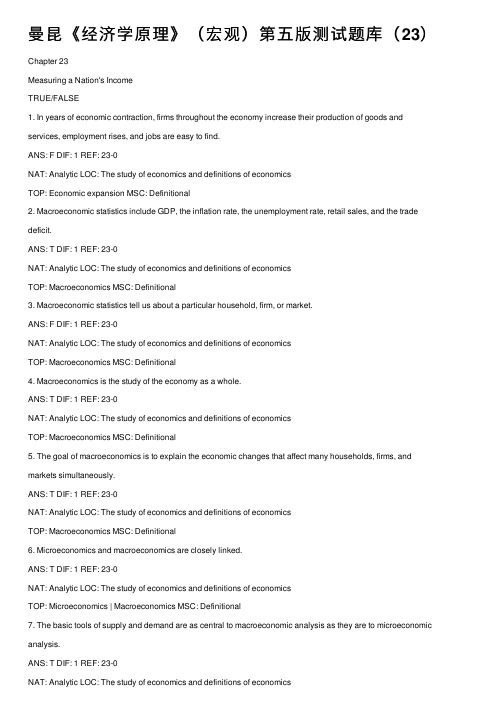
曼昆《经济学原理》(宏观)第五版测试题库(23)Chapter 23Measuring a Nation's IncomeTRUE/FALSE1. In years of economic contraction, firms throughout the economy increase their production of goods and services, employment rises, and jobs are easy to find.ANS: F DIF: 1 REF: 23-0NAT: Analytic LOC: The study of economics and definitions of economicsTOP: Economic expansion MSC: Definitional2. Macroeconomic statistics include GDP, the inflation rate, the unemployment rate, retail sales, and the trade deficit.ANS: T DIF: 1 REF: 23-0NAT: Analytic LOC: The study of economics and definitions of economicsTOP: Macroeconomics MSC: Definitional3. Macroeconomic statistics tell us about a particular household, firm, or market.ANS: F DIF: 1 REF: 23-0NAT: Analytic LOC: The study of economics and definitions of economicsTOP: Macroeconomics MSC: Definitional4. Macroeconomics is the study of the economy as a whole.ANS: T DIF: 1 REF: 23-0NAT: Analytic LOC: The study of economics and definitions of economicsTOP: Macroeconomics MSC: Definitional5. The goal of macroeconomics is to explain the economic changes that affect many households, firms, and markets simultaneously.ANS: T DIF: 1 REF: 23-0NAT: Analytic LOC: The study of economics and definitions of economicsTOP: Macroeconomics MSC: Definitional6. Microeconomics and macroeconomics are closely linked.ANS: T DIF: 1 REF: 23-0NAT: Analytic LOC: The study of economics and definitions of economicsTOP: Microeconomics | Macroeconomics MSC: Definitional7. The basic tools of supply and demand are as central to macroeconomic analysis as they are to microeconomic analysis.TOP: Demand | Supply MSC: Definitional8. GDP is the most closely watched economic statistic because it is thought to be the best single measure of asociety’s economic well-being.ANS: T DIF: 1 REF: 23-0NAT: Analytic LOC: The study of economics and definitions of economicsTOP: GDP MSC: Definitional9. GDP can measure either the total income of everyone in the economy or the total expenditure on theeconomy’s output of goods and services, but GDP cannot measure both at the same time.ANS: F DIF: 2 REF: 23-1NAT: Analytic LOC: The study of economics and definitions of economicsTOP: GDP MSC: Interpretive10. For an economy as a whole, income must exceed expenditure.ANS: F DIF: 1 REF: 23-1NAT: Analytic LOC: The study of economics and definitions of economics11. An economy’s income is the same as its expenditure because every transaction has a buyer and a seller. ANS: T DIF: 1 REF: 23-1NAT: Analytic LOC: The study of economics and definitions of economicsTOP: Income | Expenditure MSC: Definitional12. GDP is the market value of all final goods and services produced by a country’s citizens in a given period oftime.ANS: F DIF: 1 REF: 23-2NAT: Analytic LOC: The study of economics and definitions of economicsTOP: GDP MSC: Definitional13. GDP adds together many different kinds of products into a single measure of the value of economic activity byusing market prices.ANS: T DIF: 1 REF: 23-2NAT: Analytic LOC: The study of economics and definitions of economicsTOP: GDP MSC: Definitional14. U.S. GDP includes the market value of rental housing, but not the market value of owner-occupied housing. ANS: F DIF: 2 REF: 23-2NAT: Analytic LOC: The study of economics and definitions of economicsTOP: GDP MSC: Interpretive15. U.S. GDP excludes the production of most illegal goods.ANS: T DIF: 2 REF: 23-2NAT: Analytic LOC: The study of economics and definitions of economics16. U.S. GDP includes estimates of the value of items that are produced and consumed at home, such as housework and car maintenance.ANS: F DIF: 2 REF: 23-2NAT: Analytic LOC: The study of economics and definitions of economicsTOP: GDP MSC: Applicative17. GDP includes only the value of final goods because the value of intermediate goods is already included in the prices of the final goods.ANS: T DIF: 1 REF: 23-2NAT: Analytic LOC: The study of economics and definitions of economicsTOP: GDP | Intermediate goods MSC: Definitional18. Additions to inventory subtract from GDP, and when the goods in inventory are later used or sold, the reductions in inventory add to GDP.ANS: F DIF: 1 REF: 23-2NAT: Analytic LOC: The study of economics and definitions of economicsTOP: GDP | Inventory MSC: Definitional19. While GDP includes tangible goods such as books and bug spray, it excludes intangible services such as the services provided by teachers and exterminators.ANS: F DIF: 2 REF: 23-2NAT: Analytic LOC: The study of economics and definitions of economicsTOP: GDP MSC: Applicative20. At a rummage sale, you buy two old books and an old rocking chair; your spending on these items is not included in current GDP.ANS: T DIF: 2 REF: 23-2NAT: Analytic LOC: The study of economics and definitions of economicsTOP: GDP MSC: Applicative21. When an American doctor opens a practice in Bermuda, his production there is part of U.S. GDP.ANS: F DIF: 2 REF: 23-2NAT: Analytic LOC: The study of economics and definitions of economics1560 Chapter 23 /Measuring a Nation's Income22. If the U.S. government reports that GDP in the third quarter was $12 trillion at an annual rate, then the amount of income and expenditure during quarter three was $3 trillion.ANS: T DIF: 2 REF: 23-2NAT: Analytic LOC: The study of economics and definitions of economicsTOP: GDP MSC: Applicativedifferent stories about overall economic conditions.ANS: F DIF: 2 REF: 23-2NAT: Analytic LOC: The study of economics and definitions of economicsTOP: GDP | Income MSC: Interpretive24. Expenditures by households on education are included in the consumption component of GDP.ANS: T DIF: 2 REF: 23-3NAT: Analytic LOC: The study of economics and definitions of economicsTOP: Consumption MSC: Interpretive25. Most goods whose purchases are included in the investment component of GDP are used to produce other goods.ANS: T DIF: 2 REF: 23-3NAT: Analytic LOC: The study of economics and definitions of economicsTOP: Investment MSC: Interpretive26. New home construction is included in the consumption component of GDP.ANS: F DIF: 2 REF: 23-3NAT: Analytic LOC: The study of economics and definitions of economicsTOP: Investment MSC: Interpretive27. Changes in inventory are included in the investment component of GDP.ANS: T DIF: 2 REF: 23-3NAT: Analytic LOC: The study of economics and definitions of economicsTOP: Investment MSC: Interpretive28. The investment component of GDP refers to financial investment in stocks and bonds.ANS: F DIF: 2 REF: 23-3NAT: Analytic LOC: The study of economics and definitions of economicsTOP: Investment MSC: Interpretive29. The government purchases component of GDP includes salaries paid to soldiers but not Social Security benefits paid to the elderly.ANS: T DIF: 2 REF: 23-3NAT: Analytic LOC: The study of economics and definitions of economicsTOP: Government purchases MSC: Interpretive30. If the value of an economy’s imports exceeds the value of that economy’s exports, then net exports is a negative number.ANS: T DIF: 2 REF: 23-3NAT: Analytic LOC: The study of economics and definitions of economics31. If someone in the United States buys a surfboard produced in Australia, then that purchase is included in both the consumption component of U.S. GDP and the net exports component of U.S. GDP.ANS: T DIF: 2 REF: 23-3NAT: Analytic LOC: The study of economics and definitions of economicsTOP: Consumption | Net exports MSC: Applicative32. If consumption is $4000, exports are $300, government purchases are $1000, imports are $400, and investment is $800, then GDP is $5700.ANS: T DIF: 2 REF: 23-3NAT: Analytic LOC: The study of economics and definitions of economics33. If exports are $500, GDP is $8000, government purchases are $1200, imports are $700, and investment is $800, then consumption is $6200.ANS: T DIF: 2 REF: 23-3NAT: Analytic LOC: The study of economics and definitions of economicsTOP: Consumption MSC: Applicative34. If consumption is $1800, GDP is $4300, government purchases are $1000, imports are $700, and investment i s $1200, then exports are $300.ANS: F DIF: 2 REF: 23-3NAT: Analytic LOC: The study of economics and definitions of economicsTOP: Exports MSC: Applicative35. U.S. GDP was almost $14 billion in 2007.ANS: F DIF: 1 REF: 23-3NAT: Analytic LOC: The study of economics and definitions of economicsTOP: GDP MSC: Definitional36. In 2007, government purchases was the largest component of U.S. GDP.ANS: F DIF: 2 REF: 23-3NAT: Analytic LOC: The study of economics and definitions of economicsTOP: GDP MSC: Interpretive37. If total spending rises from one year to the next, then the economy must be producing a larger output of goods and services.ANS: F DIF: 2 REF: 23-4NAT: Analytic LOC: The study of economics and definitions of economicsTOP: GDP MSC: Interpretive38. An increase in nominal U.S. GDP necessarily implies that the United States is producing a larger output of goods and services.TOP: Nominal GDP MSC: Interpretive39. Nominal GDP uses constant base-year prices to place a value on the economy’s production of goods a nd services, while real GDP uses current prices to place a value on the economy’s production of goods and services.ANS: F DIF: 1 REF: 23-4NAT: Analytic LOC: The study of economics and definitions of economicsTOP: Nominal GDP | Real GDP MSC: Definitional40. Real GDP evaluates current production using prices that are fixed at past levels and therefore shows how the economy’s overall production of goods and services changes over time.ANS: T DIF: 1 REF: 23-4NAT: Analytic LOC: The study of economics and definitions of economicsTOP: Real GDP MSC: Definitional41. The term real GDP refers to a country’s actual GDP as opposed to its estimated GDP.ANS: F DIF: 2 REF: 23-4NAT: Analytic LOC: The study of economics and definitions of economicsTOP: Real GDP MSC: Interpretive42. Changes in real GDP reflect only changes in the amounts being produced.ANS: T DIF: 1 REF: 23-4NAT: Analytic LOC: The study of economics and definitions of economicsTOP: Real GDP MSC: Definitional43. Real GDP is a better gauge of economic well-being than is nominal GDP.ANS: T DIF: 1 REF: 23-4NAT: Analytic LOC: The study of economics and definitions of economics1562 Chapter 23 /Measuring a Nation's Income44. Changes in the GDP deflator reflect only changes in the prices of goods and services.ANS: T DIF: 2 REF: 23-4NAT: Analytic LOC: The study of economics and definitions of economicsTOP: GDP deflator MSC: Interpretive45. If nominal GDP is $10,000 and real GDP is $8,000, then the GDP deflator is 125.ANS: T DIF: 2 REF: 23-4NAT: Analytic LOC: The study of economics and definitions of economicsTOP: GDP deflator MSC: Applicative46. If nominal GDP is $12,000 and the GDP deflator is 80, then real GDP is $15,000.TOP: Real GDP MSC: Applicative47. Economists use the term inflation to describe a situation in whic h the economy’s overall production level isrising.ANS: F DIF: 1 REF: 23-4NAT: Analytic LOC: Unemployment and inflation TOP: InflationMSC: Definitional48. If the GDP deflator in 2006 was 160 and the GDP deflator in 2007 was 180, then the inflation rate in 2007 was12.5%.ANS: T DIF: 2 REF: 23-4NAT: Analytic LOC: Unemployment and inflation TOP: Inflation rateMSC: Applicative49. If the GDP deflator in 2004 was 150 and the GDP deflator in 2005 was 120, then the inflation rate in 2005 was25%.ANS: F DIF: 2 REF: 23-4NAT: Analytic LOC: Unemployment and inflation TOP: Inflation rateMSC: Applicative50. The GDP deflator can be used to take inflation out of nominal GDP.ANS: T DIF: 1 REF: 23-4NAT: Analytic LOC: The study of economics and definitions of economicsTOP: GDP deflator MSC: Definitional51. In 2004, the level of U.S. real GDP was close to four times its 1965 l evel.ANS: T DIF: 1 REF: 23-4NAT: Analytic LOC: The study of economics and definitions of economicsTOP: Real GDP MSC: Definitional52. The output of goods and services produced in the United States has grown on average 3.2 percent per year. ANS: T DIF: 1 REF: 23-4NAT: Analytic LOC: Productivity and growthTOP: GrowthMSC: Definitional53. Periods during which real GDP rises are called recessions.ANS: F DIF: 1 REF: 23-4NAT: Analytic LOC: The study of economics and definitions of economicsTOP: Recessions MSC: Definitional54. Recessions are associated with lower incomes, rising unemployment, and falling profits.TOP: Recessions MSC: Definitional55. If real GDP is higher in one country than in another, then we can be sure that the standard of living is higher inthe country with the higher real GDP.ANS: F DIF: 2 REF: 23-5NAT: Analytic LOC: The study of economics and definitions of economicsTOP: Real GDP | Standard of living MSC: Interpretive56. Real GDP per person tells us the income and expenditure of the average person in the economy.ANS: T DIF: 1 REF: 23-5NAT: Analytic LOC: The study of economics and definitions of economicsTOP: Real GDP per person MSC: Definitional57. GDP does not directly measure those things that make life worthwhile, but it does measure our ability toobtain many of the inputs into a worthwhile life.ANS: T DIF: 1 REF: 23-5NAT: Analytic LOC: The study of economics and definitions of economicsTOP: GDP MSC: Definitional58. GDP does not make adjustments for leisure time, environmental quality, or volunteer work.ANS: T DIF: 2 REF: 23-5NAT: Analytic LOC: The study of economics and definitions of economicsTOP: GDP MSC: Interpretive59. Other things equal, in countries with higher levels of real GDP per person, life expectancy and literacy ratesare higher than in countries with lower levels of real GDP per person.ANS: T DIF: 2 REF: 23-5NAT: Analytic LOC: The study of economics and definitions of economicsTOP: GDP MSC: InterpretiveSHORT ANSWER1. GDP is defined as the market value of all final goods and services produced within a country in a given periodof time. In spite of this definition, some production is left out of GDP. Explain why some final goods and services are not included.ANS:GDP excludes some products because they are so difficult to measure. These products include services performed by individuals for themselves and their families, and most goods that are produced and consumed at home and, therefore, never enter the marketplace. In addition, illegal products are not included in GDP even if they can be measured because, by society's definition, they are bads, not goods.DIF: 2 REF: 23-2 NAT: AnalyticLOC: The study of economics and definitions of economics TOP: GDPMSC: Interpretiveincluded directly as part of GDP, but the value of intermediate goods produced and not sold is includeddirectly as part of GDP.ANS:Intermediate goods produced and sold during the year are not included separately as part of GDP because the value of those goods is included in the value of the final goods produced from them. If the intermediate good is produced but not sold during the year, its value is included as inventory investment for the year in which it was produced. If inventory investment was not included as part of GDP, true production would be underestimated for the year the intermediate good went into inventory, and overestimated for the year the intermediate good is used or sold.DIF: 2 REF: 23-2 NAT: AnalyticLOC: The study of economics and definitions of economics TOP: GDP | Intermediate goods MSC: Interpretive1564 Chapter 23 /Measuring a Nation's Income3. Since it is counted as investment, why doesn't the purchase of earthmoving equipment from China by a U.S.corporation increase U.S. GDP?ANS:The purchase of foreign equipment is counted as investment, but GDP measures only the value of production within the geographic borders of the United States. In order to avoid including the value of the imported equipment, imports are subtracted from GDP. Hence, the value of the equipment in investment is canceled by subtracting its value as an import.DIF: 2 REF: 23-3 NAT: AnalyticLOC: The study of economics and definitions of economics TOP: GDP | Investment | Imports MSC: Applicative4. Identify the immediate effect of each of the following events on U.S. GDP and its components.a. James receives a Social Security check.b. John buys an Italian sports car.c. Henry buys domestically produced tools for his construction company.ANS:a. Since this is a transfer payment, there is no change to GDP or to any of its components.b. Consumption and imports will rise and cancel each other out so that there is no change in U.S. G DP.c. This increases the investment component of GDP and so increases GDP.DIF: 2 REF: 23-3 NAT: AnalyticLOC: The study of economics and definitions of economicsTOP: GDP | Transfer payments | Net exports | Investment MSC: Applicative5. Between 1929 and 1933, NNP measured in current prices fell from $96 billion to $48 billion. Over the sameperiod, the relevant price index fell from 100 to 75.a. What was the percentage decline in nominal NNP from 1929 to1933?b. What was the percentage decline in real NNP from 1929 to 1933? Show your work.ANS:a. NNP measured in current prices is nominal NNP. Nominal NNP fell from $96 billion to $48 billion, adecline of 50 percent.($96 b/100) 100 = $96 b. Real NNP in 1933 was ($48 b/75) 100 = $64 b. Real NNP fell from$96 billion to $64 billion, a decline of 33 percent.DIF: 2 REF: 23-4 NAT: AnalyticLOC: The study of economics and definitions of economics TOP: Nominal NNP | Real NNP MSC: Applicative6. You find that your paycheck for the year is higher this year than last. Does that mean that your real incomehas increased? Explain carefully.ANS:Real income is nominal income adjusted for general increase in prices. I f my paycheck is higher this year than last, my nominal income has increased. Whether my real income has increased or not depends on what has happened since last year to the level of prices of things I buy with my income. If the percentage increase in prices is less than the percentage increase in my nominal income, then my real income h as increased. Otherwise, my real income has not increased.DIF: 2 REF: 23-4 NAT: AnalyticLOC: The study of economics and definitions of economicsTOP: Nominal income | Real income MSC: Interpretive7. U.S. real GDP is substantially higher today than it was 60 years ago. What does this tell us, and what does itnot tell us, about the well-being of U.S. residents?ANS:Since this is in real terms, it tells us that the U.S. is able to make a lot more stuff than in the past. Some of the increase in real GDP is probably due to an increase in population, so we could say more if we knew what had happened to real GDP per person. Supposing that there was also an increase in real GDP per person, we can say that the standard of living has risen. Material things are an important part of well-being. Having sufficient amounts of things such as food, shelter, and clothing are fundamental to well-being. Other things such as security, a safe environment, access to safe water, access to medical care, justice, and freedom also matter. However, many of these things are more easily obtained by being able to produce more using fewer resources. Countries with higher real GDP per person tend to have longer life spans, less discrimination towards women, less child labor, and a higher rate of literacy.DIF: 2 REF: 23-5 NAT: AnalyticLOC: The study of economics and definitions of economicsTOP: Real GDP | Economic welfare MSC: InterpretiveSec00 - Measuring a Nation's IncomeMULTIPLE CHOICE1. Statistics that are of particular interest to macroeconomistsa. are largely ignored by the media.b. are widely reported by the media.c. include the equilibrium prices of individual goods and services.d. tell us about a particular household, firm, or market.ANS: B DIF: 2 REF: 23-0NAT: Analytic LOC: The study of economics and definitions of economicsTOP: Macroeconomics MSC: Interpretiveb. the interaction between households and firms.c. economy-wide phenomena.d. regulations on firms and unions.ANS: C DIF: 1 REF: 23-0NAT: Analytic LOC: The study of economics and definitions of economicsTOP: Macroeconomics MSC: Definitional3. Which of the following newspaper headlines is more closely related to what microeconomists study than to what macroeconomists study?a. Unemployment rate rises from 5 percent to 5.5 percent.b. Real GDP grows by 3.1 percent in the third quarter.c. Retail sales at stores show large gains.d. The price of oranges rises after an early frost.ANS: D DIF: 2 REF: 23-0NAT: Analytic LOC: The study of economics and definitions of economicsTOP: Microeconomics | Macroeconomics MSC: Interpretive4. Which of the following questions is more likely to be studied by a microeconomist than a macroeconomist?a. Why do prices in general rise by more in some countries than in others?b. Why do wages differ across industries?c. Why do production and income increase in some periods and not in others?d. How rapidly is GDP currently increasing?ANS: B DIF: 2 REF: 23-0NAT: Analytic LOC: The study of economics and definitions of economicsTOP: Microeconomics | Macroeconomics MSC: Interpretive1566 Chapter 23 /Measuring a Nation's Income5. Which of the following topics are more likely to be studied by a macroeconomist than by a microeconomist?a. the effect of taxes on the prices of airline tickets, the profitability of automobile-manufacturingfirms, and employment trends in the food-service industryb. the price of beef, wage differences between genders, and antitrust lawsc. how consumers maximize utility, and how prices are established in markets for agriculturalproductsd. the percentage of the labor force that is out of work, and differences in average income fromcountry to countryANS: D DIF: 2 REF: 23-0NAT: Analytic LOC: The study of economics and definitions of economicsTOP: Microeconomics | Macroeconomics MSC: Interpretive6. We would expect a macroeconomist, as opposed to a microeconomist, to be particularly interested ina. explaining how economic changes affect prices of particular goods.b. devising policies to deal with market failures such as externalities and market power.c. devising policies to promote low inflation.d. identifying those markets that are competitive and those that are not competitive.ANS: C DIF: 2 REF: 23-0NAT: Analytic LOC: The study of economics and definitions of economicsTOP: Microeconomics | Macroeconomics MSC: Interpretive7. Which of the following is not a question that macroeconomists address?a. Why is average income high in some countries while it is low in others?b. Why does the price of oil rise when war erupts in the Middle East?c. Why do production and employment expand in some years and contract in others?d. Why do prices rise rapidly in some periods of time while they are more stable in other periods? ANS: B DIF: 2 REF: 23-0 NAT: Analytic LOC: The study of economics and definitions of economicsTOP: Macroeconomics MSC: Interpretive8. The basic tools of supply and demand area. useful only in the analysis of economic behavior in individual markets.b. useful in analyzing the overall economy, but not in analyzing individual markets.c. central to microeconomic analysis, but seldom used in macroeconomic analysis.d. central to macroeconomic analysis as well as to microeconomic analysis.ANS: D DIF: 1 REF: 23-0NAT: Analytic LOC: The study of economics and definitions of economicsTOP: Demand | Supply MSC: Definitional9. Which of the following statistic is usually regarded as the best single measure of a society’s economic well-being?a. the unemployment rateb. the inflation ratec. gross domestic productd. the trade deficitANS: C DIF: 1 REF: 23-0NAT: Analytic LOC: The study of economics and definitions of economicsTOP: GDP MSC: DefinitionalSec01 - Measuring a Nation's Income - The Economy's Income and Expenditure MULTIPLE CHOICE1. Which of the following statements about GDP is correct?a. GDP measures two things at once: the total income of everyone in the economy and the unemployment rate of the economy’s labor force.b. Money continuously flows from households to government and then back to households, and GDP measures this flow of money.c. GDP is to a nation’s economy as household income is to a household.d. All of the above are correct.ANS: C DIF: 2 REF: 23-1NAT: Analytic LOC: The study of economics and definitions of economicsTOP: GDP MSC: Interpretive2. Gross domestic product measures two things at once:a. the total spending of everyone in the economy and the total saving of everyone in the economy.b. the total income of everyone in the economy and the total expenditure on the economy's output of goods and services.c. the value of the economy's output of goods and services for domestic citizens and the value of the economy's output of goods and services for the rest of the world.d. the total income of households in the economy and the total profit of firms in the economy. ANS: B DIF: 1 REF: 23-1NAT: Analytic LOC: The study of economics and definitions of economicsTOP: GDP MSC: Definitional3. For an economy as a whole,a. wages must equal profit.b. consumption must equal saving.c. income must equal expenditure.d. the number of buyers must equal the number of sellers.ANS: C DIF: 2 REF: 23-1NAT: Analytic LOC: The study of economics and definitions of economicsTOP: Income | Expenditure MSC: Interpretive4. For an economy as a whole, income must equal expenditure becausea. the number of firms is equal to the number of households in an economy.b. international law requires that income equal expenditure.c. every dollar of spending by some buyer is a dollar of income for some seller.d. every dollar of saving by some consumer is a dollar of spending by some other consumer. ANS: C DIF: 2 REF: 23-1NAT: Analytic LOC: The study of economics and definitions of economicsTOP: Income | Expenditure MSC: Interpretive5. If an economy’s GDP rises, then it must be the case that the economy’sa. income rises and saving falls.b. income and saving both rise.c. income rises and expenditure falls.d. income and expenditure both rise.ANS: D DIF: 2 REF: 23-1NAT: Analytic LOC: The study of economics and definitions of economics TOP: Income | Expenditure MSC: Interpretive。
3.Economic Growth

3.1 Schools of Macroeconomics
Neoclassical Synthesizers
• pick best elements of Classical and Keynesian approaches • Economy is ―Keynesian‖ in the short run but ―Classical‖ in the long run • Long-run AS curve vertical, short-run AS curve upward sloping
3. Economic Growth
3.1 Schools of Thought in Macroeconomics 3.2 Solow-Swan Growth Model 3.3 Endogenous Growth Models
3.1 Schools of Macroeconomics
The most important schools of thought
k 0 k
The Solow-Swan Growth Model
Case 1: No technological progress
saving and investment
S (t ) I (t ) (t ) sY (t ) K (t ) K (t ) Y (t ) K (t ) K s ( ) L(t ) L(t ) L(t ) (t ) K sy (t ) k (t ) L(t )
The Solow-Swan Growth Model
Case 1: No technological progress
Capital per capita and its change
《经济学原理·曼昆·第三版》第23章
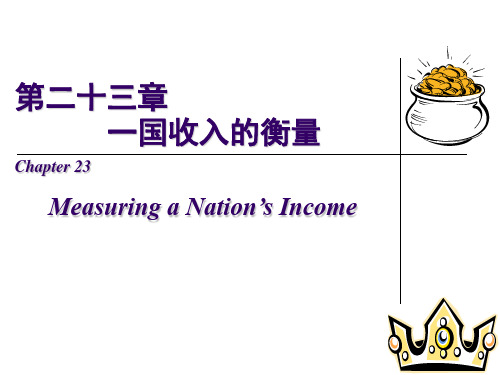
补充:GDP的测算法
现在通常采用三种测算法:生产法,收入法,支出法,
1.生产法:GDP=∑各产业部门的总产出-∑各产业部门的中间 消耗 2.收入法:GDP=∑各产业部门劳动者报酬+∑各产业部门固 定资产折旧+∑各产业部门生产税净额+∑各产业部门营业利 润 或:GDP=工资+利息+利润+租金+间接税+企业转移支付+折 旧+误差
chapter23measuringanationsincomechapter23measuringanationsincome考虑为什么一个经济的总收入等于其总支出考虑为什么一个经济的总收入等于其总支出了解如何定义和计算国内生产总值gdp了解实际考虑gdp了解如何定义和计算国内生产总值了解实际gdp考虑是不是经济福利良好的衡量指标gdpgdp与名义gdp是不是经济福利良好的衡量指标与名义gdpgdp之间的区别之间的区别说明为什么收入等于支出等于产量说明为什么收入等于支出等于产量解释gdp定义消费定义消费投资投资用基期和当年价格计算实际gdp列出许多中并不包括解释gdp定义中的关键词汇和短语政府购买和净出口政府购买和净出口定义中的关键词汇和短语用基期和当年价格计算实际列出许多gdpgdp和名义但能提高福利的活动但能提高福利的活动和名义gdpgdpgdp中并不包括prologueasyoumayrecallfromchapter2economicsisdividedintotwobranches
23.2.1 “GDP是市场价值…” “GDP Is the Market Value . . .”
宏观经济学之经济增长Economic Growth(精品PPT课件共27页)
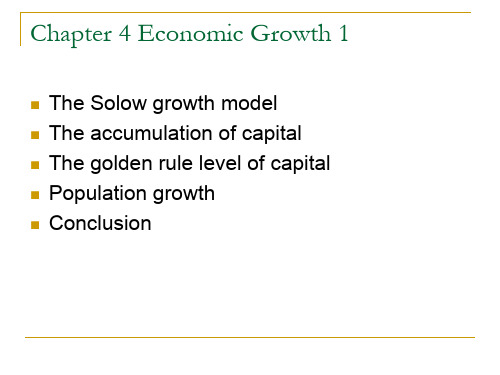
c* = f (k*) –δ k*
MPK – δ = 0,MPK = δ At the Golden Rule level of capital, the
4-3 Population Growth
The steady state with population growth k = s f (k) – (δ + n )k
The effects of population growth MPK – δ =n
Slide 14
Mankiw:Macroeconomics, 4/e © by Worth Publishers, Inc.
Slide 7
Mankiw:Macroeconomics, 4/e © by Worth Publishers, Inc.
Slide 8
Mankiw:Macroeconomics, 4/e © by Worth Publishers, Inc.
4-2 The Golden Rule level of capital
Comparing steady state Finding the Golden Rule steady state: a
numerical example The transition to the Golden Rule steady
state
Comparing steady state
state Approaching the steady state: a numerical
agrue economic growth 英语阅读
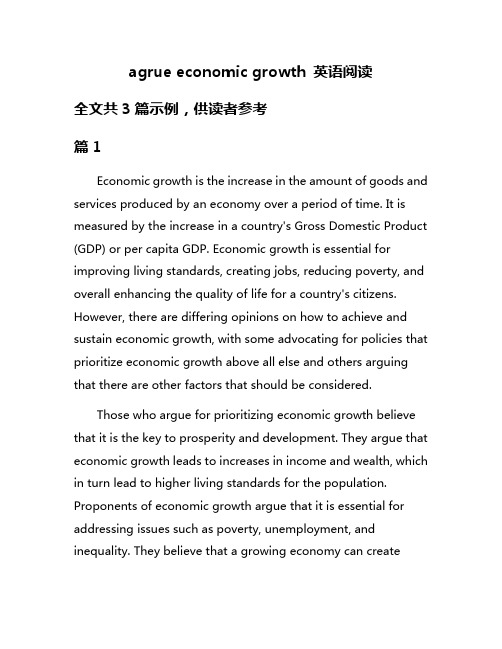
agrue economic growth 英语阅读全文共3篇示例,供读者参考篇1Economic growth is the increase in the amount of goods and services produced by an economy over a period of time. It is measured by the increase in a country's Gross Domestic Product (GDP) or per capita GDP. Economic growth is essential for improving living standards, creating jobs, reducing poverty, and overall enhancing the quality of life for a country's citizens. However, there are differing opinions on how to achieve and sustain economic growth, with some advocating for policies that prioritize economic growth above all else and others arguing that there are other factors that should be considered.Those who argue for prioritizing economic growth believe that it is the key to prosperity and development. They argue that economic growth leads to increases in income and wealth, which in turn lead to higher living standards for the population. Proponents of economic growth argue that it is essential for addressing issues such as poverty, unemployment, and inequality. They believe that a growing economy can createopportunities for businesses to expand, create new jobs, and stimulate innovation and technological advancement.On the other hand, there are those who argue that economic growth should not be the sole focus of economic policy. They argue that there are other important factors to consider, such as environmental sustainability, social welfare, and income distribution. They believe that pursuing economic growth at all costs can have negative consequences, such as environmental degradation, resource depletion, and social unrest. They argue that it is important to strike a balance between economic growth and other considerations, such as social equity and environmental protection.One of the key debates surrounding economic growth is the question of whether it is possible to achieve sustainable economic growth. Sustainable economic growth is growth that meets the needs of the present without compromising the ability of future generations to meet their own needs. This requires taking into account environmental, social, and economic factors in decision-making processes. Some argue that it is not possible to achieve sustainable economic growth within the current economic system, which is based on constant growth andconsumption. They argue that a new economic model is needed that prioritizes sustainability over growth.Another debate surrounding economic growth is the question of whether economic growth is inclusive. Inclusive economic growth is growth that benefits all segments of society, particularly the most vulnerable and marginalized populations. Some argue that economic growth can exacerbate inequality, if the benefits of growth are not distributed equitably. They argue that policies need to be put in place to ensure that the benefits of economic growth are shared by all members of society. This may include measures such as progressive taxation, social welfare programs, and investment in education and healthcare.In conclusion, economic growth is a complex and multifaceted concept that has profound implications for society as a whole. While economic growth is important for improving living standards and reducing poverty, it is crucial to consider other factors such as sustainability, inclusivity, and equity in economic policy. Achieving sustainable and inclusive economic growth requires careful consideration of all these factors and a balance between economic growth and other societal goals. Ultimately, the goal should be to create an economy thatbenefits all members of society and ensures a high quality of life for present and future generations.篇2Economic growth refers to an increase in the production of goods and services in an economy over time. It is often measured by the percentage increase in a country's Gross Domestic Product (GDP). Economic growth is important as it leads to higher standards of living, increased employment opportunities, and overall economic development. However, there is ongoing debate among economists and policymakers about the impact and sustainability of economic growth.Some argue that economic growth is necessary to lift people out of poverty and improve living standards. When the economy grows, there is more wealth to be distributed, leading to higher wages, increased job opportunities, and better access to goods and services. This can result in improvements in healthcare, education, and infrastructure, which ultimately benefit the population as a whole.Proponents of economic growth also argue that it can help address social issues such as inequality and poverty. As the economy expands, there is more revenue available for socialwelfare programs, which can help support vulnerable populations and reduce disparities in income and wealth. Economic growth can also lead to technological advancements and innovation, which can create new industries and improve productivity, further driving economic development.On the other hand, some critics argue that economic growth can have negative consequences for the environment and society. Rapid economic growth often leads to increased consumption of natural resources, pollution, and environmental degradation. This can have a detrimental impact on ecosystems, biodiversity, and climate change, leading to long-term sustainability challenges.Moreover, economic growth does not always translate into improvements in well-being for all members of society. In many cases, economic growth can exacerbate inequality, with the benefits of growth disproportionately accruing to the wealthy. This can widen the gap between the rich and the poor, leading to social unrest and instability.Furthermore, the pursuit of endless economic growth may not be sustainable in the long run. As resources become scarce and environmental constraints become more pronounced, there are growing concerns about the ability of the planet to supportcontinued economic expansion. This has led to calls for a reevaluation of our current economic model, with a focus on more sustainable and equitable forms of development.In conclusion, while economic growth has its benefits, it is important to consider the broader social and environmental implications of our economic policies. It is crucial to strike a balance between economic growth and sustainability, ensuring that growth is inclusive, equitable, and environmentally sustainable. By addressing these challenges, we can create a more prosperous and sustainable future for all.篇3Economic growth is a key goal for many countries around the world. It is often seen as a measure of a country's success and development. In recent years, there has been a growing debate about the best way to achieve economic growth and whether it is always a positive thing.Many economists argue that economic growth is essential for improving living standards and reducing poverty. They believe that a growing economy creates jobs, increases income, and provides better opportunities for people to improve their lives. Economic growth can also lead to increased investment ininfrastructure, education, and healthcare, which can benefit society as a whole.However, there are also those who argue that the pursuit of economic growth can have negative consequences. They point to issues such as environmental degradation, social inequality, and unsustainable consumption patterns as potential drawbacks of prioritizing growth above all else. Some critics of economic growth argue that a focus on GDP growth alone can overlook other important aspects of human well-being, such as health, education, and happiness.One of the key arguments against economic growth is its impact on the environment. As economies grow, they often consume more resources, produce more waste, and emit more pollutants. This can lead to a range of environmental problems, including climate change, deforestation, and pollution. Critics argue that these environmental costs are often not fully accounted for in traditional measures of economic growth, leading to an overemphasis on short-term economic gains at the expense of long-term environmental sustainability.Social inequality is another important consideration in the debate over economic growth. While economic growth can lead to higher incomes and improved living standards for manypeople, it can also widen the gap between the rich and the poor. In many countries, economic growth has been accompanied by rising levels of inequality, with the benefits of growth disproportionately accruing to the wealthiest members of society. This can lead to social unrest, political instability, and a range of other negative consequences.Another criticism of economic growth is that it can foster unsustainable patterns of consumption and production. As economies grow, they often become more reliant on fossil fuels, intensive agriculture, and other resource-intensive industries. This can lead to overexploitation of natural resources, depletion of ecosystems, and increased pollution. Critics argue that this kind of growth is not sustainable in the long term and will ultimately undermine the well-being of future generations.In conclusion, the debate over economic growth is complex and multifaceted. While there are clear benefits to economic growth, such as higher incomes, improved living standards, and increased opportunities for development, there are also important drawbacks to consider. These include environmental degradation, social inequality, and unsustainable consumption patterns. It is important for policymakers to carefully consider these trade-offs and to pursue a form of economic growth that issustainable, inclusive, and benefits society as a whole. By taking a more holistic approach to economic development, countries can ensure that growth is both meaningful and beneficial for all members of society.。
经济增长(英文版PPT)Economic Growth
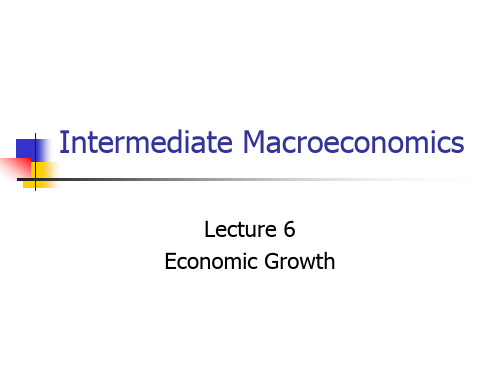
The Golden Rule Level of Capital
From the Solow model
y c i c y i
At the steady state:
c* y * i *
c* f (k*) k *
Choose k* to maximize c*
the Golden Rule steady state
Per Capita ---
Y F ( K ,1)
L
L
y f (k)
The Accumulation of Capital
The production function
y y=f(k)
y k
y MPK
k
k
The Accumulation of Capital
2. The demand for goods
k*
s2
2
The Accumulation of Capital
s=0.15, =0.05, k=1 k*=9
k
y c inv. dep. change in k
1
1 1 0.85 0.15 0.05
0.1
2 1.1 1.05 0.89 0.16 0.055 0.1023213 3 1.202 1.1 0.93 0.16 0.06 0.1043596
Static analysis (Ch. 3) Dynamic
The Accumulation of Capital
1. The supply for goods Production function: Y F (K, L) Characteristics: CRS aY F(aK, aL)
economic growth
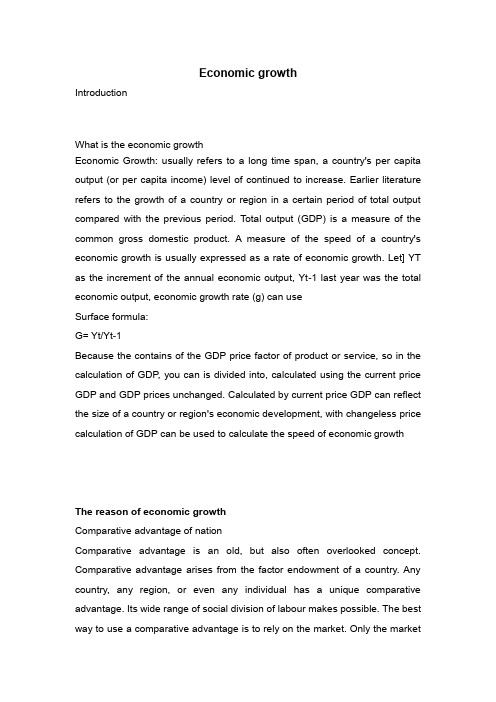
Economic growthIntroductionWhat is the economic growthEconomic Growth: usually refers to a long time span, a country's per capita output (or per capita income) level of continued to increase. Earlier literature refers to the growth of a country or region in a certain period of total output compared with the previous period. Total output (GDP) is a measure of the common gross domestic product. A measure of the speed of a country's economic growth is usually expressed as a rate of economic growth. Let] YT as the increment of the annual economic output, Yt-1 last year was the total economic output, economic growth rate (g) can useSurface formula:G= Yt/Yt-1Because the contains of the GDP price factor of product or service, so in the calculation of GDP, you can is divided into, calculated using the current price GDP and GDP prices unchanged. Calculated by current price GDP can reflect the size of a country or region's economic development, with changeless price calculation of GDP can be used to calculate the speed of economic growthThe reason of economic growthComparative advantage of nationComparative advantage is an old, but also often overlooked concept. Comparative advantage arises from the factor endowment of a country. Any country, any region, or even any individual has a unique comparative advantage. Its wide range of social division of labour makes possible. The best way to use a comparative advantage is to rely on the market. Only the marketcan play a role in the pricing of countless items, and the price is the national, regional and individual to determine the essential parameters of their comparative advantage. The intervention of the state to the market if the price signal distortion, will hinder the economic main body to own comparative advantage, thus causes the social resources cannot be effectively utilized. The past history and the current crisis in Southeast Asia have illustrated this point.Supply of public goodsHowever, the use of comparative advantage cannot be separated from the accumulation of public goods. Public goods is a product that is external, that is, the social benefits generated by the individual is more than the cost of the individual is willing to bear. In this case, the government's intervention is necessary. The effective public goods supply needs to improve the market mechanism and the leadership mechanism. This requires a reasonable mechanism to regulate and supervise the leaders' leadership. The foundation of the effective provision of public goods is the cooperation of the whole society, the stability and sustained growth of the economy, and the normal flow of full employment and resources. East Asian countries have done well in the provision of public goods, mainly in their investment in education, social infrastructure.The recovery of employment and revival of strong growth requires more than short-term monetary easing and temporary fiscal stimulus./ebook.jsf?bid=CBO9781139 059589The determinants of economicprogress - what are the critical factors which make for continuedgrowth, be it through the growth of productive resourcesor the improvement of knowledge or technology; (Kaldor, Nicholas, 1986)/yorksj/items/dda-4/CR9780511559709?query=economic+growth&resultsUri=items%3Fquery%3Deconomic%2Bgrowth%26facet %255B0%255D%3Dfulltext%253Ayes%26facet%255B1%255D%3Dformat%2 53A%2522ebook%2522%26target%3Dcatalogue%26offset%3D50&facet%5B 0%5D=fulltext%3Ayes&facet%5B1%5D=format%3A%22ebook%22&target=c atalogueThe policy of economic growth:●Policy of interest rates●Tax policy●Finance policy●Exchange rate policyThe disadvantage and advantage of economic growthConclusion。
Economic growth
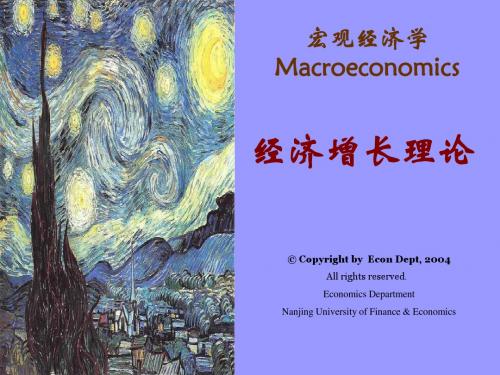
法国 5.7 2.3 3.3 1.7
英国 3.1 1.4 3.1 -0.9
转自:Dornbusch & Fischer 《宏观经济学》
经济增长理论 Slide 12
经济增长因素分析
时期
1960-1973
增长衰退:全要素生产率的增长率下降
美国 4.0 日本 9.6 德国 4.4 法国 5.7 英国 3.1
k sy ( n)k
经济增长理论
Slide 24
索洛模型
稳态(Steady State)分析
稳态:经济处于长期均衡状态
人均资本存量保持不变 k 0 * * sf ( k ) ( n ) k y 即:
(n )k
y f (k )
——储蓄刚好满足资本损耗 以及新增劳动力的资本配备需要
人均产量增长1.81%,其中1.49%源于技术进
步。
经济增长理论
Slide 6
经济增长的源泉
索洛剩余
经济增长率中没有被劳动和资本增长所解释
的那部分。
——全要素生产率的增长率
经济增长理论
Slide 7
经济增长的源泉
爱德华· 丹尼森(1985)
经济增长因素:
要素投入量: 资本 劳动 单位要素的产出(要素生产率): 知识 资源配置效率 规模经济
经济增长的源泉
库兹涅茨
——强调技术进步在经济增长中的作用
知识存量的增长
知识的转化率
生产率的提高 经济结构:农业经济非农经济
经济增长理论
Slide 10
经济增长的源泉
经济增长与收入分配的倒U形假说
曼昆经济学原理(宏观分册)第23章课后习题答案(英文版)
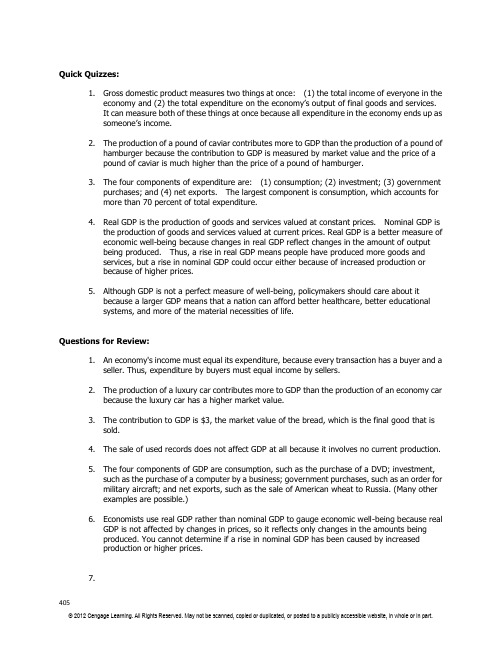
Quick Quizzes:1. Gross domestic product measures two things at once: (1) the total income of everyone in theeconomy and (2) the total expenditure on the economy’s output of final goods and services.It can measure both of these things at once because all expenditure in the economy ends up assomeone’s income.2. The production of a pound of caviar contributes more to GDP than the production of a pound ofhamburger because the contribution to GDP is measured by market value and the price of apound of caviar is much higher than the price of a pound of hamburger.3. The four components of expenditure are: (1) consumption; (2) investment; (3) governmentpurchases; and (4) net exports. The largest component is consumption, which accounts formore than 70 percent of total expenditure.4. Real GDP is the production of goods and services valued at constant prices. Nominal GDP isthe production of goods and services valued at current prices. Real GDP is a better measure ofeconomic well-being because changes in real GDP reflect changes in the amount of outputbeing produced. Thus, a rise in real GDP means people have produced more goods andservices, but a rise in nominal GDP could occur either because of increased production orbecause of higher prices.5. Although GDP is not a perfect measure of well-being, policymakers should care about itbecause a larger GDP means that a nation can afford better healthcare, better educationalsystems, and more of the material necessities of life.Questions for Review:1. An economy's income must equal its expenditure, because every transaction has a buyer and aseller. Thus, expenditure by buyers must equal income by sellers.2. The production of a luxury car contributes more to GDP than the production of an economy carbecause the luxury car has a higher market value.3. The contribution to GDP is $3, the market value of the bread, which is the final good that issold.4. The sale of used records does not affect GDP at all because it involves no current production.5. The four components of GDP are consumption, such as the purchase of a DVD; investment,such as the purchase of a computer by a business; government purchases, such as an order formilitary aircraft; and net exports, such as the sale of American wheat to Russia. (Many otherexamples are possible.)6. Economists use real GDP rather than nominal GDP to gauge economic well-being because realGDP is not affected by changes in prices, so it reflects only changes in the amounts beingproduced. You cannot determine if a rise in nominal GDP has been caused by increasedproduction or higher prices.7.405The percentage change in nominal GDP is (600 – 200)/200 x 100% = 200%. The percentagechange in real GDP is (400 – 200)/200 x 100% = 100%. The percentage change in the deflator is (150 – 100)/100 x 100% = 50%.8. It is desirable for a country to have a large GDP because people could enjoy more goods andservices. But GDP is not the only important measure of well-being. For example, laws thatrestrict pollution cause GDP to be lower. If laws against pollution were eliminated, GDP wouldbe higher but the pollution might make us worse off. Or, for example, an earthquake wouldraise GDP, as expenditures on cleanup, repair, and rebuilding increase. But an earthquake is anundesirable event that lowers our welfare.Problems and Applications1. a. Consumption increases because a refrigerator is a good purchased by a household.b. Investment increases because a house is an investment good.c. Consumption increases because a car is a good purchased by a household, but investmentdecreases because the car in Ford’s inventory had been counted as an investment gooduntil it was sold.d. Consumption increases because pizza is a good purchased by a household.e. Government purchases increase because the government spent money to provide a goodto the public.f. Consumption increases because the bottle is a good purchased by a household, but netexports decrease because the bottle was imported.g. Investment increases because new structures and equipment were built.2. With transfer payments, nothing is produced, so there is no contribution to GDP.3. If GDP included goods that are resold, it would be counting output of that particular year, plussales of goods produced in a previous year. It would double-count goods that were sold morethan once and would count goods in GDP for several years if they were produced in one yearand resold in another.4. a. Calculating nominal GDP:2010: ($1 per qt. of milk ⨯ 100 qts. milk) + ($2 per qt. of honey ⨯ 50 qts. honey) = $2002011: ($1 per qt. of milk ⨯ 200 qts. milk) + ($2 per qt. of honey ⨯ 100 qts. honey) = $4002012: ($2 per qt. of milk ⨯ 200 qts. milk) + ($4 per qt. of honey ⨯ 100 qts. honey) = $800Calculating real GDP (base year 2010):2010: ($1 per qt. of milk ⨯ 100 qts. milk) + ($2 per qt. of honey ⨯ 50 qts. honey) = $2002011: ($1 per qt. of milk ⨯ 200 qts. milk) + ($2 per qt. of honey ⨯ 100 qts. honey) = $4002012: ($1 per qt. of milk ⨯ 200 qts. milk) + ($2 per qt. of honey ⨯ 100 qts. honey) = $400 Calculating the GDP deflator:2010: ($200/$200) ⨯ 100 = 1002011: ($400/$400) ⨯ 100 = 1002012: ($800/$400) ⨯ 100 = 200b. Calculating the percentage change in nominal GDP:Percentage change in nominal GDP in 2011 = [($400 – $200)/$200] ⨯ 100% = 100%.Percentage change in nominal GDP in 2012 = [($800 – $400)/$400] ⨯ 100% = 100%.Calculating the percentage change in real GDP:Percentage change in real GDP in 2011 = [($400 – $200)/$200] ⨯ 100% = 100%.Percentage change in real GDP in 2012 = [($400 – $400)/$400] ⨯ 100% = 0%.Calculating the percentage change in GDP deflator:Percentage change in the GDP deflator in 2011 = [(100 – 100)/100] ⨯ 100% = 0%.Percentage change in the GDP deflator in 2012 = [(200 – 100)/100] ⨯ 100% = 100%.Prices did not change from 2010 to 2011. Thus, the percentage change in the GDP deflator is zero. Likewise, output levels did not change from 2011 to 2012. This means that thepercentage change in real GDP is zero.c. Economic well-being rose more in 2010 than in 2011, since real GDP rose in 2011 but not in2012. In 2011, real GDP rose but prices did not. In 2012, real GDP did not rise but prices did.5. a. C alculating Nominal GDP:Year 1: (3 bars ⨯ $4) = $12Year 2: (4 bars ⨯ $5) = $20Year 3: (5 bars ⨯ $6) = $30b. C alculating Real GDP:Year 1: (3 bars ⨯ $4) = $12Year 2: (4 bars ⨯ $4) = $16Year 3: (5 bars ⨯ $4) = $20c. Calculating the GDP delator:Year 1: $12/$12 ⨯ 100 = 100Year 2: $20/$16 ⨯ 100 = 125Year 3: $30/$20 ⨯ 100 = 150d. T he growth rate from Year 2 to Year 3 = (16 – 12)/12 ⨯ 100% = 4/12 ⨯ 100% = 33.3%e. The inflation rate from Year 2 to Year 3 = (150 – 125)/125 ⨯ 100% = 25/125 ⨯ 100% =20%.f. To calculate the growth rate of real GDP, we could simply calculate the percentage changein the quantity of bars. To calculate the inflation rate, we could measure the percentage change in the price of bars.6.a. The growth rate of nominal GDP = 100% ⨯ [($14,256/$9,353)0.10– 1] = 4.3%b. The growth rate of the deflator = 100% ⨯ [(109.886.8)0.10– 1] = 2.4%c. Real GDP in 1999 (in 2005 dollars) is $9,353/(86.8/100) = $10,775.35.d. Real GDP in 2009 (in 2005 dollars) is $14,256/(109.8/100) = $12,983.61.e. The growth rate of real GDP = 100% ⨯ [($12,983.61/$10,775.35)0.10– 1] = 1.9%f. The growth rate of nominal GDP is higher than the growth rate of real GDP because ofinflation.7. Many answers are possible.8. a. GDP is the market value of the final good sold, $180.b. Value added for the farmer: $100.Value added for the miller: $150 – $100 = $50.Value added for the baker: $180 – $150 = $30.c. Together, the value added for the three producers is $100 + $50 + $30 = $180. This is thevalue of GDP.9. In countries like India, people produce and consume a fair amount of food at home that is notincluded in GDP. So GDP per person in India and the United States will differ by more than their comparative economic well-being.10. a. The increased labor-force participation of women has increased GDP in the United States,because it means more people are working and production has increased.b. If our measure of well-being included time spent working in the home and taking leisure, itwould not rise as much as GDP, because the rise in women's labor-force participation has reduced time spent working in the home and taking leisure.c. Other aspects of well-being that are associated with the rise in women's increasedlabor-force participation include increased self-esteem and prestige for women in theworkforce, especially at managerial levels, but decreased quality time spent with children, whose parents have less time to spend with them. Such aspects would be quite difficult to measure.11. a. GDP equals the dollar amount Barry collects, which is $400.b. NNP = GDP – depreciation = $400 – $50 = $350.c. National income = NNP = $350.d. Personal income = national income – retained earnings – indirect business taxes = $350 –$100 – $30 = $220.e. Disposable personal income = personal income – personal income tax = $220 – $70 =$150.。
曼昆宏观经济学 23章英文答案
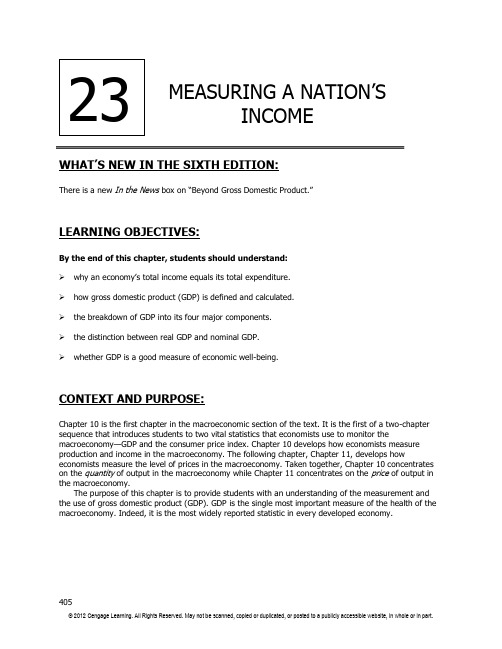
405WHAT’S NEW IN THE SIXTH EDITION:There is a new In the News box on ―Beyond Gross Domestic Product.‖LEARNING OBJECTIVES:By the end of this chapter, students should understand:why an economy’s total income equ als its total expenditure.how gross domestic product (GDP) is defined and calculated.the breakdown of GDP into its four major components.the distinction between real GDP and nominal GDP.whether GDP is a good measure of economic well-being.CONTEXT AND PURPOSE:Chapter 10 is the first chapter in the macroeconomic section of the text. It is the first of a two-chapter sequence that introduces students to two vital statistics that economists use to monitor themacroeconomy —GDP and the consumer price index. Chapter 10 develops how economists measure production and income in the macroeconomy. The following chapter, Chapter 11, develops howeconomists measure the level of prices in the macroeconomy. Taken together, Chapter 10 concentrates on the quantity of output in the macroeconomy while Chapter 11 concentrates on the price of output in the macroeconomy.The purpose of this chapter is to provide students with an understanding of the measurement and the use of gross domestic product (GDP). GDP is the single most important measure of the health of the macroeconomy. Indeed, it is the most widely reported statistic in every developed economy.MEASURING A NATION’SINCOME406 ❖Chapter 23/Measuring a Nation’s IncomeKEY POINTS:∙ Because every transaction has a buyer and a seller, the total expenditure in the economy must equal the total income in the economy.∙ Gross domestic product (GDP) measures an economy’s total expenditure on newly produced goods and services and the total income earned from the production of these goods and services. More precisely, GDP is the market value of all final goods and services produced within a country in a given period of time.∙ GDP is divided among four components of expenditure: consumption, investment, government purchases, and net exports. Consumption includes spending on goods and services by households, with the exception of purchases of new housing. Investment includes spending on new equipment and structures, including households’ pur chases of new housing. Government purchases include spending on goods and services by local, state, and federal governments. Net exports equal the value of goods and services produced domestically and sold abroad (exports) minus the value of goods and services produced abroad and sold domestically (imports).∙ Nominal GDP uses current prices to value the economy’s production of goods and services. Real GDP uses constant base-year prices to value the economy’s production of goods and services. The GDP defla tor―calculated from the ratio of nominal to real GDP―measures the level of prices in theeconomy.∙ GDP is a good measure of economic well-being because people prefer higher incomes to lower incomes. But it is not a perfect measure of well-being. For example, GDP excludes the value ofleisure and the value of a clean environment.CHAPTER OUTLINE:I. Review of the Definitions of Microeconomics and MacroeconomicsA. Definition of microeconomics: the study of how households and firms make decisionsand how they interact in markets.B. Definition of macroeconomics: the study of economy-wide phenomena includinginflation, unemployment, and economic growth.II. The Economy’s Income and ExpenditureA. To judge whether or not an economy is doing well, it is useful to look at Gross Domestic Product(GDP).Chapter 23/Measuring a Natio n’s Income ❖ 4071. GDP measures the total income of everyone in the economy.2. GDP measures total expenditure on an economy’s output of goods and services.B. For an economy as a whole, total income must equal total expenditure.1. If someone pays someone else $100 to mow a lawn, the expenditure on the lawn service($100) is exactly equal to the income earned from the production of the lawn service ($100).2. We can also use the circular-flow diagram from Chapter 2 to show why total income and totalexpenditure must be equal.a. Households buy goods and services from firms; firms use this money to pay for resourcespurchased from households.b. In the simple economy described by this circular-flow diagram, calculating GDP could bedone by adding up the total purchases of households or summing total income earned by households.408 ❖ Chapter 23/Measuring a Nation’s Incomec. Note that this simple diagram is somewhat unrealistic as it omits saving, taxes,government purchases, and investment purchases by firms. However, because atransaction always has a buyer and a seller, total expenditure in the economy must be equal to total income.III. The Measurement of Gross Domestic ProductA. Definition of gross domestic product (GDP): the market value of all final goods andservices produced within a country in a given period of time .B. ―GDP Is the Market Value . . .‖ 1. To add together different items, market values are used. 2. Market values are calculated by using market prices.C. ―. . . Of All . . .‖1. GDP includes all items produced and sold legally in the economy.2. The value of housing services is somewhat difficult to measure.a. If housing is rented, the value of the rent is used to measure the value of the housingservices. b. For housing that is owned (or mortgaged), the government estimates the rental valueand uses this figure to value the housing services. 3. GDP does not include illegal goods or services or items that are not sold in markets. a. When you hire someone to mow your lawn, that production is included in GDP.b. If you mow your own lawn, that production is not included in GDP.D. ―. . . Final . . .‖ 2. The value of intermediate goods is already included as part of the value of the final good.Chapter 23/Measuring a Natio n’s Income❖4093. Goods that are placed into inventory are considered to be ―final‖ and included in GDP as afirm’s inventory investment.a. Goods that are sold out of inventory are counted as a decrease in inventory investment.b. The goal is to count the production when the good is finished, which is not necessarilythe same time that the product is sold.E. ―. . . Goods and Services . . .‖1. GDP includes both tangible goods and intangible services.F. ―. . . Produced . . .‖1. Only current production is counted.2. Used goods that are sold do not count as part of GDP.G. ―. . . Within a Country . . .‖1. GDP measures the production that takes place within the geographical boundaries of aparticular country.2. If a Canadian citizen works temporarily in the United States, the value of his output isincluded in GDP for the United States. If an American owns a factory in Haiti, the value of the production of that factory is not included in U.S. GDP.H. ―. . . in a Given Period of Time.‖1. The usual interval of time used to measure GDP is a quarter (three months).2. When the government reports GDP, the data are generally reported on an annual basis.3. In addition, data are generally adjusted for regular seasonal changes (such as Christmas).I. In addition to summing expenditure, the government also calculates GDP by adding up totalincome in the economy.1. The two ways of calculating GDP almost exactly give the same answer.2. The difference between the two calculations of GDP is called the statistical discrepancy.410 ❖ Chapter 23/Measuring a Nation’s IncomeJ. FYI: Other Measures of IncomeA. Gross National Product (GNP) is the total income earned by a nation’s permanent residents.1. GNP includes income that American citizens earn abroad.2. GNP excludes income that foreigners earn in the United States.B. Net National Product (NNP) is the total income of a nation’s residents (GNP) minus losses fromdepreciation (wear and tear on an economy’s stock of equipment and structures).C. Nati onal income is the total income earned by a nation’s residents in the production of goods andservices.1. National income differs from NNP by excluding indirect business taxes and including businesssubsidies.2. NNP and national income also differ due to ―statistical discrepancy.‖ D. Personal income is the income that households and noncorporate businesses receive.E. Disposable personal income is the income that households and noncorporate businesses have leftafter taxes and other obligations to the government.IV. The Components of GDPA. GDP (Y ) can be divided into four components: consumption (C ), investment (I ), governmentpurchases (G ), and net exports (NX ).B. Definition of consumption: spending by households on goods and services, with theexception of purchases of new housing . C. Definition of investment: spending on capital equipment, inventories, and structures,including household purchases of new housing .1. GDP accounting uses the word ―investment‖ differently from how w e use the term ineveryday conversation.2. When a student hears the word ―investment,‖ he or she thinks of financial instruments suchas stocks and bonds.Chapter 23/Measuring a Natio n’s Income ❖ 4113. In GDP accounting, investment means purchases of investment goods such as capitalequipment, inventories, or structures.D. Definition of government purchases: spending on goods and services by local, state,and federal governments .1. Salaries of government workers are counted as part of the government purchases componentof GDP. 2. Transfer payments are not included as part of the government purchases component of GDP.E. Definition of net exports: spending on domestically produced goods by foreigners(exports) minus spending on foreign goods by domestic residents (imports).F. Case Study: The Components of U.S. GDP1. Table 1 shows these four components of GDP for 2009.2. The data for GDP come from the Bureau of Economic Analysis, which is part of theDepartment of Commerce. V. Real Versus Nominal GDPA. There are two possible reasons for total spending to rise from one year to the next.1. The economy may be producing a larger output of goods and services.2. Goods and services could be selling at higher prices.B. When studying GDP over time, economists would like to know if output has changed (not prices).C. Thus, economists measure real GDP by valuing output using a fixed set of prices.D. A Numerical Example412 ❖ Chapter 23/Measuring a Nation’s Income1. Two goods are being produced: hot dogs and hamburgers.2. Definition of nominal GDP: the production of goods and services valued at currentprices .Nominal GDP for 2010 = ($1 × 100) + ($2 × 50) = $200. Nominal GDP for 2011 = ($2 × 150) + ($3 × 100) = $600. Nominal GDP for 2012 = ($3 × 200) + ($4 × 150) = $1,200.3. Definition of real GDP: the production of goods and services valued at constantprices .Let’s assume that the base year is 2008.Real GDP for 2010 = ($1 × 100) + ($2 × 50) = $200. Real GDP for 2011 = ($1 × 150) + ($2 × 100) = $350. Real GDP for 2012 = ($1 × 200) + ($2 × 150) = $500. E. Because real GDP is unaffected by changes in prices over time, changes in real GDP reflectchanges in the amount of goods and services produced.Chapter 23/Measuring a Natio n’s Income ❖ 413F. The GDP Deflator1. Definition of GDP deflator: a measure of the price level calculated as the ratio ofnominal GDP to real GDP times 100.2. Example CalculationsGDP Deflator for 2010 = ($200 / $200) × 100 = 100. GDP Deflator for 2011 = ($600 / $350) × 100 = 171. GDP Deflator for 2012 = ($1200 / $500) × 100 = 240.G. Case Study: Real GDP over Recent History1. Figure 2 shows quarterly data on real GDP for the United States since 1965.2. We can see that real GDP has increased over time.414 ❖ Chapter 23/Measuring a Nation’s Income3. We can also see that there are times when real GDP declines. These periods are calledrecessions. VI. Is GDP a Good Measure of Economic Well-Being?A. GDP measures both an economy’s total income and its total expenditure on goods and services.B. GDP per person tells us the income and expenditure level of the average person in the economy.C. GDP, however, may not be a very good measure of the economic well-being of an individual.1. GDP omits important factors in the quality of life including leisure, the quality of theenvironment, and the value of goods produced but not sold in formal markets.2. GDP also says nothing about the distribution of income.3. However, a higher GDP does help us achieve a good life. Nations with larger GDP generallyhave better education and better health care.D. In the News: The Underground Economy1. The measurement of GDP misses many transactions that take place in the undergroundeconomy.2. This article compares the underground economies of the United States and several othercountries.E. Case Study: International Differences in GDP and the Quality of Life1. Table 3 shows real GDP per person, life expectancy, adult literacy rates, and Internet usagefor 12 countries.2. In rich countries, life expectancy is higher and adult literacy and Internet usage rates arealso high. 3. In poor countries, people typically live only into their 50s, only about half of the adultpopulation is literate, and Internet usage is very rare.F. In the News: Beyond Gross Domestic Product1. Some economists wonder if we need a better measure of economic well-being.2. This is an article from The New York Times describing some criticisms of using GDP solely tomeasure economic well-being.SOLUTIONS TO TEXT PROBLEMS:Quick Quizzes:1. Gross domestic product measures two things at once: (1) the total income of everyone inthe economy and (2) the total exp enditure on the economy’s output of final goods andservices. It can measure both of these things at once because all expenditure in theeconomy ends up as someone’s income.2. The production of a pound of caviar contributes more to GDP than the production of a poundof hamburger because the contribution to GDP is measured by market value and the price ofa pound of caviar is much higher than the price of a pound of hamburger.3. The four components of expenditure are: (1) consumption; (2) investment; (3) governmentpurchases; and (4) net exports. The largest component is consumption, which accounts formore than 70 percent of total expenditure.4. Real GDP is the production of goods and services valued at constant prices. Nominal GDP isthe production of goods and services valued at current prices. Real GDP is a better measureof economic well-being because changes in real GDP reflect changes in the amount of outputbeing produced. Thus, a rise in real GDP means people have produced more goods andservices, but a rise in nominal GDP could occur either because of increased production orbecause of higher prices.5. Although GDP is not a perfect measure of well-being, policymakers should care about itbecause a larger GDP means that a nation can afford better healthcare, better educationalsystems, and more of the material necessities of life.Questions for Review:1. An economy's income must equal its expenditure, because every transaction has a buyer anda seller. Thus, expenditure by buyers must equal income by sellers.2. The production of a luxury car contributes more to GDP than the production of an economycar because the luxury car has a higher market value.3. The contribution to GDP is $3, the market value of the bread, which is the final good that issold.4. The sale of used records does not affect GDP at all because it involves no current production.5. The four components of GDP are consumption, such as the purchase of a DVD; investment,such as the purchase of a computer by a business; government purchases, such as an orderfor military aircraft; and net exports, such as the sale of American wheat to Russia. (Manyother examples are possible.)6. Economists use real GDP rather than nominal GDP to gauge economic well-being becausereal GDP is not affected by changes in prices, so it reflects only changes in the amountsbeing produced. You cannot determine if a rise in nominal GDP has been caused byincreased production or higher prices.7.The percentage change in nominal GDP is (600 – 200)/200 x 100% = 200%. The percentagechange in real GDP is (400 – 200)/200 x 100% = 100%. The percentage change in the deflator is (150 – 100)/100 x 100% = 50%.8. It is desirable for a country to have a large GDP because people could enjoy more goods andservices. But GDP is not the only important measure of well-being. For example, laws thatrestrict pollution cause GDP to be lower. If laws against pollution were eliminated, GDP wouldbe higher but the pollution might make us worse off. Or, for example, an earthquake wouldraise GDP, as expenditures on cleanup, repair, and rebuilding increase. But an earthquake isan undesirable event that lowers our welfare.Problems and Applications1. a. Consumption increases because a refrigerator is a good purchased by a household.b. Investment increases because a house is an investment good.c. Consumption increases because a car is a good purchased by a household, butinvestment decreases because the car in Ford’s inventory had been counted as aninvestment good until it was sold.d. Consumption increases because pizza is a good purchased by a household.e. Government purchases increase because the government spent money to provide a goodto the public.f. Consumption increases because the bottle is a good purchased by a household, but netexports decrease because the bottle was imported.g. Investment increases because new structures and equipment were built.2. With transfer payments, nothing is produced, so there is no contribution to GDP.3. If GDP included goods that are resold, it would be counting output of that particular year,plus sales of goods produced in a previous year. It would double-count goods that were soldmore than once and would count goods in GDP for several years if they were produced inone year and resold in another.4. a. Calculating nominal GDP:2010: ($1 per qt. of milk ⨯ 100 qts. milk) + ($2 per qt. of honey ⨯ 50 qts. honey) = $2002011: ($1 per qt. of milk ⨯ 200 qts. milk) + ($2 per qt. of honey ⨯ 100 qts. honey) =$4002012: ($2 per qt. of milk ⨯ 200 qts. milk) + ($4 per qt. of honey ⨯ 100 qts. honey) =$800Calculating real GDP (base year 2010):2010: ($1 per qt. of milk ⨯ 100 qts. milk) + ($2 per qt. of honey ⨯ 50 qts. honey) = $2002011: ($1 per qt. of milk ⨯ 200 qts. milk) + ($2 per qt. of honey ⨯ 100 qts. honey) =$4002012: ($1 per qt. of milk ⨯ 200 qts. milk) + ($2 per qt. of honey ⨯ 100 qts. honey) =$400Calculating the GDP deflator:2010: ($200/$200) ⨯ 100 = 1002011: ($400/$400) ⨯ 100 = 1002012: ($800/$400) ⨯ 100 = 200b. Calculating the percentage change in nominal GDP:Percentage change in nominal GDP in 2011 = [($400 – $200)/$200] ⨯ 100% = 100%.Percentage change in nominal GDP in 2012 = [($800 – $400)/$400] ⨯ 100% = 100%.Calculating the percentage change in real GDP:Percentage change in real GDP in 2011 = [($400 – $200)/$200] ⨯ 100% = 100%.Percentage change in real GDP in 2012 = [($400 – $400)/$400] ⨯ 100% = 0%.Calculating the percentage change in GDP deflator:Percentage change in the GDP deflator in 2011 = [(100 – 100)/100] ⨯ 100% = 0%.Percentage change in the GDP deflator in 2012 = [(200 – 100)/100] ⨯ 100% = 100%.Prices did not change from 2010 to 2011. Thus, the percentage change in the GDPdeflator is zero. Likewise, output levels did not change from 2011 to 2012. This meansthat the percentage change in real GDP is zero.c. Economic well-being rose more in 2010 than in 2011, since real GDP rose in 2011 but notin 2012. In 2011, real GDP rose but prices did not. In 2012, real GDP did not rise butprices did.5. a. Calculating Nominal GDP:Year 1: (3 bars ⨯ $4) = $12Year 2: (4 bars ⨯ $5) = $20Year 3: (5 bars ⨯ $6) = $30b. Calculating Real GDP:Year 1: (3 bars ⨯ $4) = $12Year 2: (4 bars ⨯ $4) = $16Year 3: (5 bars ⨯ $4) = $20c. Calculating the GDP delator:Year 1: $12/$12 ⨯ 100 = 100Year 2: $20/$16 ⨯ 100 = 125Year 3: $30/$20 ⨯ 100 = 150d. The growth rate from Year 2 to Year 3 = (16 – 12)/12 ⨯ 100% = 4/12 ⨯ 100% = 33.3%e. The inflation rate from Year 2 to Year 3 = (150 – 125)/125 ⨯ 100% = 25/125 ⨯ 100% =20%.f. To calculate the growth rate of real GDP, we could simply calculate the percentagechange in the quantity of bars. To calculate the inflation rate, we could measure thepercentage change in the price of bars.6.a. The growth rate of nominal GDP = 100% ⨯ [($14,256/$9,353)0.10– 1] = 4.3%b. The growth rate of the deflator = 100% ⨯ [(109.886.8)0.10– 1] = 2.4%c. Real GDP in 1999 (in 2005 dollars) is $9,353/(86.8/100) = $10,775.35.d. Real GDP in 2009 (in 2005 dollars) is $14,256/(109.8/100) = $12,983.61.e. The growth rate of real GDP = 100% ⨯ [($12,983.61/$10,775.35)0.10– 1] = 1.9%f. The growth rate of nominal GDP is higher than the growth rate of real GDP because ofinflation.7. Many answers are possible.8. a. GDP is the market value of the final good sold, $180.b. Value added for the farmer: $100.Value added for the miller: $150 – $100 = $50.Value added for the baker: $180 – $150 = $30.c. Together, the value added for the three producers is $100 + $50 + $30 = $180. This isthe value of GDP.9. In countries like India, people produce and consume a fair amount of food at home that isnot included in GDP. So GDP per person in India and the United States will differ by more than their comparative economic well-being.10. a. The increased labor-force participation of women has increased GDP in the United States,because it means more people are working and production has increased.b. If our measure of well-being included time spent working in the home and taking leisure,it would not rise as much as GDP, because the rise in women's labor-force participationhas reduced time spent working in the home and taking leisure.c. Other aspects of well-being that are associated with the rise in women's increased labor-force participation include increased self-esteem and prestige for women in theworkforce, especially at managerial levels, but decreased quality time spent with children, whose parents have less time to spend with them. Such aspects would be quite difficultto measure.11. a. GDP equals the dollar amount Barry collects, which is $400.b. NNP = GDP – depreciation = $400 – $50 = $350.c. National income = NNP = $350.d. Personal income = national income – retained earnings – indirect business taxes = $350– $100 – $30 = $220.e. Disposable personal income = personal income – personal income tax = $220 – $70 =$150.。
戴维 Weil--Economic+Growth Chapter_04
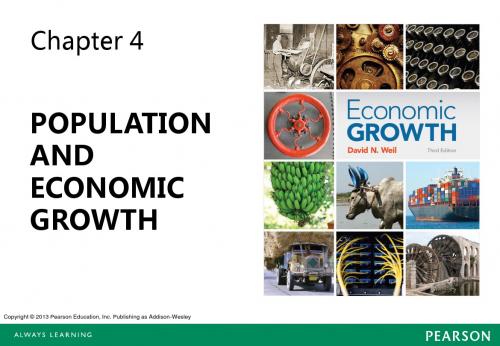
Source: Kremer (1993).
Copyright © 2013 Pearson Education, Inc. Publishing as Addison-Wesley
4-3
Figure 4.3 The Malthusian Model
Copyright © 2013 Pearson Education, Inc. Publishing as Addison-Wesley
4-18
4-4
Figure 4.4 Effect of Productivity Improvement in the Malthห้องสมุดไป่ตู้sian Model
Copyright © 2013 Pearson Education, Inc. Publishing as Addison-Wesley
4-5
Figure 4.5 Effect of “Moral Restraint” in the Malthusian Model
Copyright © 2013 Pearson Education, Inc. Publishing as Addison-Wesley
4-17
Figure 4.14 Age-Specific Fertility Rates
Copyright © 2013 Pearson Education, Inc. Publishing as Addison-Wesley
Source: Heston et. al. (2011).
Copyright © 2013 Pearson Education, Inc. Publishing as Addison-Wesley
4-2
Figure 4.2 World Population, 10,000 B.C. to A.D. 2010
宏观经济学之经济增长economic growth i(精品PPT课件共60页)
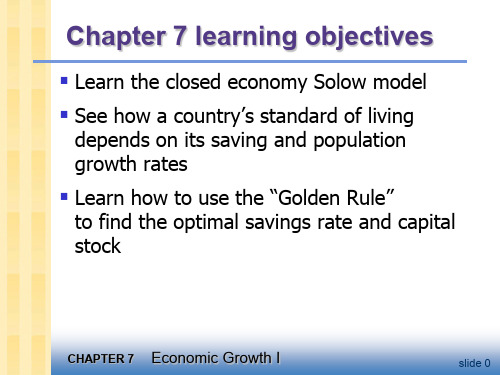
Poverty is associated with the oppression of women and minorities
CHAPTER 7 Economic Growth I
slide 3
Estimated effects of economic growth
A 10% increase in income is associated with a 6% decrease in infant mortality
slide 14
The production function
Output per
worker, y f(k)
MPK =f(k +1) – f(k)
1
Note: this production function exhibits diminishing MPK.
CHAPTER 7 Economic Growth I
Capital per
worker, k
slide 15
The national income identity
Y = C + I (remember, no G )
In “per worker” terms:
y=c+i
where c = C/L and i = I/L
CHAPTER 7 Economic Growth I
CHAPTER 7 Economic Growth I
slide 12
How Solow model is different from Chapter 3’s model
4. No G or T
(only to simplify presentation; we can still do fiscal policy experiments)
宏观经济学之经济增长economic growth ii(精品PPT课件共43页)
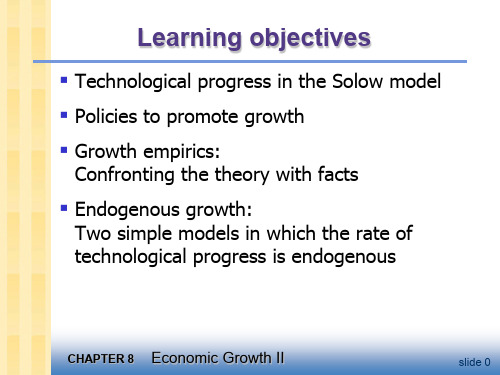
1981: 213 computers connected to the Internet
2000: 60 million computers connected to the Internet
CHAPTER 8 Economic Growth II
slide 2
Tech. progress in the Solow model
power than the first lunar landing craft in 1969.
Modems(调试解调器) are 22 times faster today than two decades ago. Since 1980, semiconductor usage per unit of GDP has increased by a
To do this, we need to compare
(MPK ) to (n + g ).
If (MPK ) > (n + g ), then we are below the
Golden Rule steady state and should increase s.
Two simple models in which the rate of technological progress is endogenous
CHAPTER 8 Economic Growth II
slide 0
Introduction
In the Solow model of Chapter 7, the production technology is held constant income per capita is constant in the steady state.
Economic Growth

经
唯一的均衡路径,使得(k(t),c(t))单调趋向于唯
济
一的稳态 k*,c*。
思
想
史 稳态人均资本由 fk*决定。如果k0k* ,
·
经
则k(t)增加达到 k *,c(t)增加达到c * ;如果 k0k*
济 增
则k(t)减少达到 k *,c(t)减少达到 c *。
·
经 济 增
k t 1 s k f t 1 k t
长
稳态
经济达到稳态时,满足条件:
经 济 思
f k*
k*
s
想 同时,
·
史 经
y*f k*
济
增 长
c * 1 sfk *
稳态
索洛模型达到稳态时,人均资本为 k*A,s,
长
Endogenous Technological Change
基本经济环境
1、连续时间无限时域经济;
经 济 思 想 史
2、存在代表性家庭:
0ex ptC1 t 11dt
3、生产函数:
Yt110Ntxv,t1dvL
·
经 4、资源约束:
·
经 一国政策当局可以调整储蓄率s使经济增长达
济 到理想的速度。
增
长
The Solow Growth Model
概述
经 济
索洛(索洛-斯旺)模型索洛和斯旺同时在 1956年提出,该模型的关键是新古典主义的
思
生产函数,其特点在于假设规模报酬不变,
想
每种投入要素的报酬递减,投入要素之间存
史
在正的替代弹性。这种生产函数和不变的储
- 1、下载文档前请自行甄别文档内容的完整性,平台不提供额外的编辑、内容补充、找答案等附加服务。
- 2、"仅部分预览"的文档,不可在线预览部分如存在完整性等问题,可反馈申请退款(可完整预览的文档不适用该条件!)。
- 3、如文档侵犯您的权益,请联系客服反馈,我们会尽快为您处理(人工客服工作时间:9:00-18:30)。
3,11% 5,18% 8,29%
Average growth in prices after deflation
1. Average Growth in Prices is: Nominal GDP – Real Real GDP 2. Based on the year 2000, real effects played a stronger role in overall output in 2007.
1.29
1.71
2.33
4.9
5.72
7.57
4
II. The Effects of the Recession on Output & Employment
2. The Decomposition Technique GDP/Capita Labour Productivity Labour Intensity Employment Demographic Rate Factor
5. Human Capital 6. Technology 0 200 225 Millions of Hours 500 (See Pages 545-547)
Therefore, 70 / 6 = 11.6 years
(See Page 537)
3
Part Two
II. Measuring the Effects of the Recession on Output & Employment
Presented by: Dr David Clowes
Suggested Reading
1
I. Real GDP & the Basics of Economic Growth
1. Economic Growth & How to Calculate it. A. Definition:
1. What is GDP & GDP per Person / Capita?
(a) GDP (b) GDP per Capita (c) GDP per Capita: Positive & Negative Interpretations
2007
I. Real GDP & the Basics of Economic Growth
Example: Price & Real Effects in Central European Economies
Income flows back to the owners of Production
.. .
B. The 70’s Rule: How long does it take to double output?
Example: Average yearly GDP per person grows at 6%.
2
I. Real GDP & the Basics of Economic Growth
2. GDP per Person & the Application of the 70’s Rule A. GDP per Person (GDP / Population)
1. GDP per Person represents a joint measure of:
(a) Ouput Side (b) Income Side
I. Real GDP & the Basics of Economic Growth
Real GDP (Trillions of $) 3. What Makes Potential GDP Grow? Increases in Labour 20 Productivity C PF1 18 1. Definition 17 PF0 2. Effects B 12 3. Preconditions A 4. Physical Capital
10 8 6
The start of the recession
4 2
-5.25
-1.05
-0.91
-0.41
Germany
Czech Rep
Hungary
Canada
Austria
Japan
Ireland
US
France
-2
3. Results Compared. Based on own Research
-4 -6
Romania
Slovakia
Italy
Spain
Poland
2. The Decomposition Technique.
UK-0.05
0
-1.32
-0.26
-0.54
1. Real GDP Capita in Selected European Countries (2007-08)
0.52
4,85% 2008 5,34% 10,19%
B. How do we calculate Real GDP Growth?
Real GDP Growth Rate = Real GDP 2011 – Real GDP 2010 Real GDP 2010
3,75% 2009 5,19% 8,94%
5
Suggested Reading
The following is recommended:
A. Consolidate your understanding of the work covered in part 1: 1. Read Chapter twenty-three. 2. Make sure that you can define GDP & GDP capita. 3. Check calculations on GDP & GDP capita growth (yearly + on average). 4. Understand the importance of labour productivity & its sources. B. The results derived from our theoretical application revealed: 1. What can be said about development levels of countries in part two? 2. Which countries observed the poorest 7 best economic performance? 3. What are the main differences between them? 4. Additional slides are included (last two) for comparative purposes.
Economic Growth
Chapter 23
Parkin, Ninth Edition
Pages 535-549
2. GDP per Person & the Application of the 70’s Rule. 3. What Makes Potential GDP Grow? II. Measuring the Effects of the Recession on Output & Employment 1. Real GDP Capita in Selected European Countries (2007-08) 2. The Decomposition Technique. 3. Results Compared
Demography 0.19 0.48 -0.02 1.19 0.6
Labour Productivity -0.23 -1.23 -0.09 0.8 0.6
Labour Intensity -1.73 -0.38 -0.73 -0.35 0.65
Employment Rate -2.68 -0.51 -0.4 -1.27 -4.42
Department of Economics
Cracow University of Economics, Poland. Introduction & Contents
Contents
I. Real GDP & the Basics of Economic Growth 1. Economic Growth & How to Calculate it.
Real GDP
8
10
Inflation
Real GDP (2011 = 200 Billion, 2010 = 188 Billion) (See Page 536)
What is the rate of growth?
* Calculations Based on EU Data for Poland, Hungary, Slovakia & the Czech Republic (2000, 2007, 2008, 2009 & 2010).
Negative Rates of GDP Capita
Group 2 GDP Capita Decomposed (2007 - 2008)
gdp gdp hours employment pop ∆ ≡∆ +∆ +∆ +∆ 15 pop hours employment pop pop
Where: GDP = Gross domestic product Pop = Population Hours = Total number of hours worked Employment = Number of people employed Pop15 = Population of working age (15-64)
